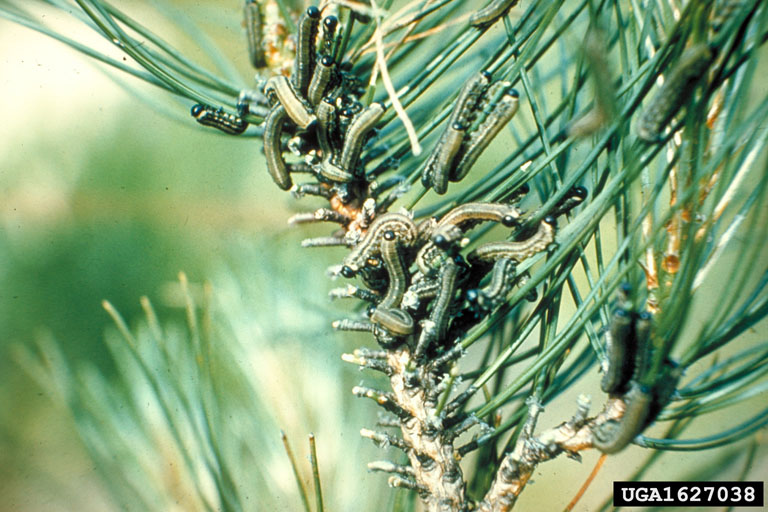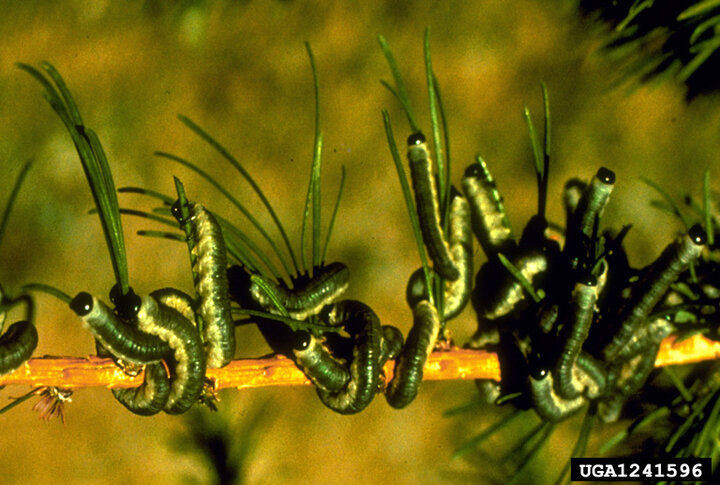
European pine sawfly colonies can cause serious defoliation on red, Scotch, and mugo pine. John A. Weidhass, Virginia Polytechnic Institute and State University, Bugwood.org.
Sawflies are a common pest found on evergreen trees in spring and they can seriously damage conifer trees through defoliation. Several species of sawflies are present in Nebraska, including the European pine sawfly (image above), yellowheaded spruce sawfly (image below left) and larch sawfly (image below right). The European pine sawfly (EPS), Neodiprion sertifer, was accidentally introduced and first found in North America in 1925 in New Jersey.
Most commonly damage is seen on Scotch, Austrian, Ponderosa, Jack and Mugo pine, along with spruce and larch. White pine is rarely damaged.

Insect Identification & Lifecycle
European pine sawfly larvae have black heads and legs, and gray-green bodies. There is an off-white stripe down the middle of the back and slightly lighter stripes on either side.
After hatching out in spring, the larvae feed in large groups on the branches of affected trees. At first the larvae eat only the outer portion of the pine needles, leaving behind the stringy, tough, central needle vein, which dies and turns brown. As the insects mature, they begin consuming entire needles.
Due to the coloration of the insects, which blends in well with the color of the needles, the insects are often not noticed until considerable defoliation has already occurred. When disturbed, larvae rear back into a defensive “S” position.

The larvae feed in groups of 10-100. They tend to eat all the needles on one branch before moving on to the next one. The missing foliage is usually very obvious, so it's easy to spot an infestation once the larvae are halfway grown.
The larvae feed for 4 to 6 weeks, eventually growing to about one inch long. Once they have finished their development – usually about the time the current year's growth is emerging from the candles – they pupate inside tough, golden brown cocoons either in the soil, in litter beneath the tree, or in protected sites on the lower trunk.
Management
Larval colonies can be removed by smashing, wiping or shaking the insects off the plants. Infested branches can also be clipped off and destroyed, but this can damage the tree's appearance as much or more than the insects will.
If you’re working with a small tree, or only a few larvae are present, then simply knock them off the tree either by hand or with a garden hose. They seldom find their way back up onto the tree and are very susceptible to predators such as birds, rodents and predatory insects.
Large populations should be treated as soon as possible. Several chemical controls can be used, such as insecticidal soaps, horticultural oils, permethrin, bifenthrin, malathion or Orthene (acephate), but all controls are most effective when the larvae are small. Dipel, or Bacillus thurengiensis, is NOT effective against sawflies because they are in the Hymenoptera family (ants & wasps), not the Lepidoptera family (butterflies & moths). Make sure the insecticide you choose to use lists sawflies on the label!
The best time to apply chemical controls is when the larvae are still young (less than 1/2 inch long) because they are more susceptible than older, larger larvae.
These insects often return year after year to the same location, so if you have problems this year, then you should be on the lookout for them next year about mid-May.
Images. Feature image - European pine sawfly. Image by John A. Weidhass, Virginia Polytechnic Institute and State University, Bugwood.org.
- Yellowheaded spruce sawfly. Image by Steven Katovich, Bugwood.org
- Larch sawfly. Image by Scott Tunnock, USDA Forest Service, Bugwood.org